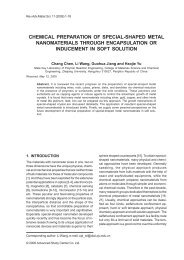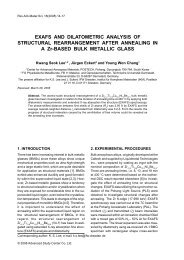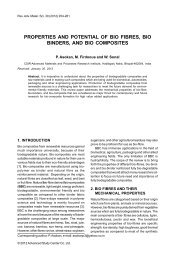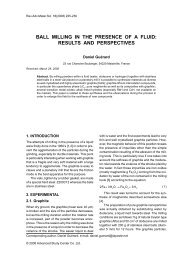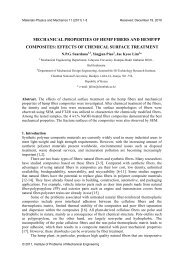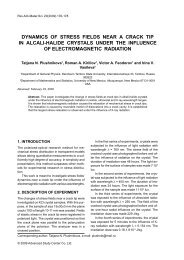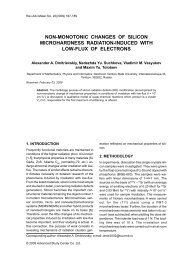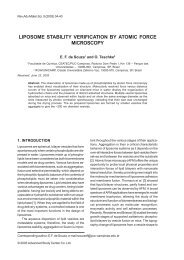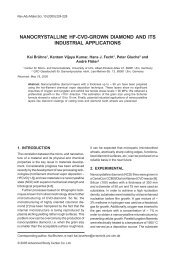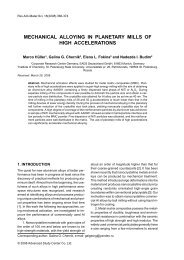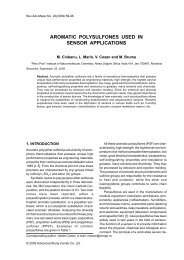surface pretreatment by phosphate conversion coatings – a review
surface pretreatment by phosphate conversion coatings – a review
surface pretreatment by phosphate conversion coatings – a review
Create successful ePaper yourself
Turn your PDF publications into a flip-book with our unique Google optimized e-Paper software.
146 T.S.N. Sankara Narayanan<br />
Fig. 6. X-ray diffraction pattern of zinc <strong>phosphate</strong> coating formed on steel (a) as-prepared; (b) partially<br />
dehydrated at 150 °C for 1 hour; (c) partially dehydrated and rehydrated at 95% RH for 70 hours. (Reprinted<br />
from Journal of Molecular Structure, Vol. 511-512, A. Stoch, Cz. Paluszkiewicz and E. Dlugon, An effect of<br />
methylaminoethoxysilane on zinc <strong>phosphate</strong> rehydration, pp. 295-299 (1999) with permission from Elsevier<br />
Science).<br />
ished or disappeared and new lines were observed<br />
at 10.90, 11.20 and 22° 2θ. During rehydration the<br />
line at 11.20° 2θ diminished while that at 9.65° 2θ<br />
grew (Fig. 6). It has been observed that the rehydration<br />
of the <strong>phosphate</strong> crystals induces residual<br />
stresses and reduce the <strong>phosphate</strong>-paint film adhesiveness<br />
[150].<br />
Numerous research reports are available to date,<br />
which elaborate the behavior of <strong>phosphate</strong> <strong>coatings</strong><br />
during chemical and thermal aggressions. The dissolution<br />
of zinc <strong>phosphate</strong> coating in high-pH environments<br />
was first reported <strong>by</strong> Wiggle et al. [142].<br />
Later, using sodium hydroxide as a simulated medium,<br />
Roberts et al. [143] demonstrated the selective<br />
leaching of phosphorous from the coating. Van<br />
Ooij and de Vries [144] interpreted X-ray photoelectron<br />
spectroscopic studies to show that hydroxyl<br />
ions exchange <strong>phosphate</strong> ions in the first few layers<br />
of the <strong>phosphate</strong> coating. Servais et al. [140]<br />
determined the chemical stability of zinc <strong>phosphate</strong><br />
<strong>coatings</strong> <strong>by</strong> subjecting them to immersion treatment<br />
in 0.8 g/l sodium hydroxide solution (pH 12.3) at 40<br />
°C for 3 minutes. Similarly, the effects of high-pH<br />
environments on zinc <strong>phosphate</strong> <strong>coatings</strong> were determined<br />
<strong>by</strong> Sommer and Leidheiser Jr. [141], using<br />
0.01, 0.1 and 1.0 M sodium hydroxide solutions.<br />
Kwiatkowski et al. [151] recommended a borate<br />
buffer solution containing 0.01 M ethylenediaminetetraacetic<br />
acid (EDTA) as the medium to test the<br />
alkaline stability of the coating and suggested its<br />
usefulness in predicting the same at a shorter time<br />
interval. All these studies uniformly agree that <strong>coatings</strong><br />
richer in phosphophyllite possess greater alkaline<br />
solubility and can serve as effective bases<br />
for cathodic electrophoretic painting.<br />
Phosphate <strong>coatings</strong> undergo marked changes<br />
when subjected to variation of temperature.<br />
Thermogravimetric technique is usually used to<br />
monitor these changes [152]. The changes occurring<br />
in zinc <strong>phosphate</strong> coating on steel upon heating<br />
was studied <strong>by</strong> Kojima et al. [148] and Sugaya<br />
and Kondo [149]. When heated above room temperature,<br />
a gradual loss in weight occurs. This was<br />
attributed to a nonstructural weight loss. However,<br />
with subsequent increase in temperature dehydration<br />
of the constituent phases of the <strong>phosphate</strong> crystals,<br />
occurs. The dehydration of hopeite<br />
[Zn (PO ) . 4H2O] and phosphophyllite<br />
3 4 2<br />
[Zn Fe(PO ) . 4H2O] commences respectively at 80<br />
2 4 2<br />
and 110 °C; however, a more pronounced weight<br />
loss occurs at approximately 150 °C, where hopeite



